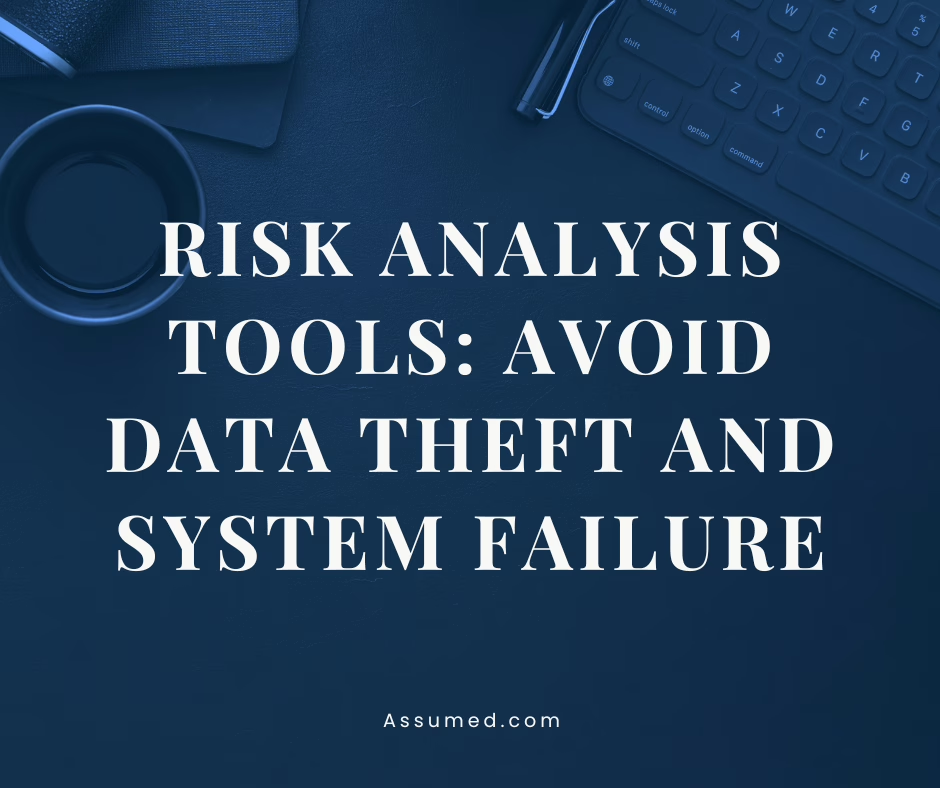Any business that deals with data will face a growing number of security threats. These threats can seriously risk companies’ operations, reputations and finances. Among the most pressing concerns, the most common digital security risks include information theft and system failure. Using risk analysis tools can help to deal with security risks before they become a problem. If you find this post helpful, consider subscribing to our newsletter for more!

Understanding Information Security Risks
Information theft and system failure represent two broad categories of digital threats that severely affect businesses. Let’s take a closer look at each:
Information Theft
Information theft involves bad actors gaining unauthorized access to sensitive data, such as:
- Customer records containing personal details, financial information and login credentials
- Proprietary business information, including product designs, strategic plans and financial projections
- Employee data, such as Social Security numbers, health records and performance evaluations

Hackers constantly probe company networks for vulnerabilities, looking for opportunities to breach systems and steal valuable data. They may use tools like malware, phishing scams and brute-force attacks to gain entry. Once inside, they can quickly exfiltrate large volumes of sensitive information, often without detection.
External threat actors represent only one category of cybersecurity risk assessment that organizations face. Internal vulnerabilities and insider threats pose equally significant challenges that require comprehensive security controls and monitoring. Insiders, such as disgruntled employees or careless contractors, can also misuse their access privileges to steal confidential data. It is inherently difficult to detect insider threats since employees already have authorized access and established trust within the organization. Their legitimate system permissions and knowledge of internal operations make suspicious activities harder to distinguish from normal work functions. Although, these threats can be detected with seeding your CRM or database. Check out Assumed Seeds to learn more about how this is possible.
Employees can create security risks in three primary scenarios:
- deliberately misusing company resources for personal financial benefit
- intentionally causing harm as an act of retaliation
- inadvertently compromising security through mistakes and oversights
The consequences of information theft can be devastating. Companies may face legal penalties and regulatory fines for failing to protect customer data. They may also suffer significant reputational damage, leading to customer trust and revenue loss. Stolen intellectual property can undermine a company’s competitive advantage and disrupt its long-term strategic plans.
System Failure
Another significant risk is system failure – the unexpected disruption or collapse of critical IT infrastructure and services. This can take many forms, such as:
- Hardware malfunctions, such as server crashes or storage device failures
- Software glitches and compatibility issues that corrupt data or cause applications to freeze
- Network outages due to equipment problems, configuration errors or cable damage
- Power disruptions, such as blackouts or surges that shut down servers and workstations
When essential systems go offline, business grinds to a halt. Employees may be unable to access the tools and data they need to do their jobs, and customers may lose money because they cannot continue operations or get support. For example, think of how devastating the CrowdStrike update was and how it caused many systems to fail and be stalled.
In some cases, system failures can also lead to data loss or corruption. Without proper backups and recovery procedures, companies may permanently lose important records, intellectual property and other valuable digital assets.
The costs of downtime can quickly add up. According to Ponemon Institute, the average price of IT downtime is nearly $9,000 per minute. For large enterprises, the costs can be much higher. Even brief outages can result in substantial financial losses, damaged customer relationships and lost productivity.
The Importance of Cyber Risk Assessment
Due to these and more digital threats, organizations must actively identify and address security risks. A strategic approach is necessary to protect against these challenges, so businesses should conduct a cyber risk assessment.
A cyber risk assessment comprehensively evaluates an organization’s IT environment and security posture. It involves using specialized risk analysis tools and methodologies to:
- Inventory and classify critical digital assets, such as hardware, software, data and network resources
- Identify potential vulnerabilities and weaknesses that attackers could exploit
- Evaluate the likelihood and potential impact of different threat scenarios
- Prioritize risks based on their severity and the organization’s risk tolerance
- Develop a prioritized plan for addressing the most significant risks through security controls and process improvements
Regular security assessments help companies understand their current cyber risks and vulnerabilities. This insight enables leadership to strategically allocate security resources and budget toward the most critical areas requiring protection.
Modern risk analysis tools and platforms can streamline and automate many aspects of the assessment process. They can scan networks and systems for known vulnerabilities, simulate attack scenarios and generate detailed reports with actionable recommendations for remediation.
Some advanced tools use machine learning and predictive analytics to identify emerging threats and anticipate future risks. Security monitoring tools scan logs, network data, and employee activities to identify suspicious patterns and unusual behaviors. These automated systems help detect potential security breaches and insider threats that manual monitoring could miss.
However, it’s important to remember that cyber risk assessment is not a one-time exercise. Organizations must continually assess their security posture, as cybersecurity threats and internal technology systems change frequently. Previously manageable risks may intensify, while new vulnerabilities can surface unexpectedly, requiring regular security controls and procedures updates. To stay ahead of these challenges, organizations must make risk assessment a regular part of their security program, with frequent reviews and updates based on the latest threat intelligence and business needs.
Building a Strong, Layered Defense Using Risk Analysis Tools
A strong security program requires multiple integrated layers of protection. Organizations should combine strong technical safeguards, security policies, and thorough employee training. This comprehensive approach helps prevent data breaches, system outages, and other cybersecurity risks.
Access controls are one of the most fundamental aspects of controlling information security risks. Companies should restrict user access permissions to only what employees need for their roles and responsibilities. This minimizes security risks by limiting exposure to sensitive systems and data.
Restricting access should be done through role-based access controls (RBAC), which define different levels of access based on job function, and through multi-factor authentication (MFA), which requires users to provide additional forms of identification beyond a password, such as a fingerprint or security token.
Encryption is another critical component of a strong defense. Organizations can protect data from unauthorized access and tampering by encrypting data at rest (when stored on servers or devices) and in transit (when transmitted over networks). Organizations should choose encryption tools that meet two essential requirements: the encryption must be strong enough to effectively protect their sensitive data, and the encryption methods must be industry-tested and verified by security professionals.
Network segmentation can also help limit the potential damage of a security breach. Network segmentation creates distinct, isolated sections within an organization’s IT infrastructure. Dividing the network into distinct sections helps protect an organization’s data and systems. Each department has its own isolated network area, with the most valuable assets in highly secure zones. This structure prevents attackers who gain access to one location from moving freely throughout the network to reach sensitive resources. This containment strategy significantly reduces the potential damage from a security breach.
Even with strong preventive controls in place, organizations need to be able to quickly detect and respond to security incidents when they occur. This requires continuous monitoring of systems and networks for signs of suspicious activity, such as unusual login attempts, data exfiltration or configuration changes. Security information and event management (SIEM) tools and advanced analytics can help identify potential threats and investigate incidents.
Finally, having a well-defined incident response plan will minimize the impact of security incidents. An effective strategy should include clear roles and responsibilities for the response team, procedures for containing and eradicating threats, communication protocols for notifying stakeholders and post-incident review to identify lessons learned and areas for improvement. Regular practice and plan refinement can be achieved through exercises and simulations. These should also be done to keep employees sharp and confident in incident response.
The Business Case for Proactive Security
Implementing a comprehensive security program can require financial investment, particularly for larger, more at-risk organizations. The costs of preventive security measures are significantly lower than the potential economic impact of a major security incident, which can include breach response costs, regulatory fines, reputational damage and lost business opportunities. Though investing in cybersecurity risk assessment may require significant upfront costs, the financial impact of inadequate security measures will be substantially more significant. A major security incident typically incurs immediate monetary losses through regulatory penalties and legal settlements while inflicting long-term damage to an organization’s market position and stakeholder relationships. Building up your information security risks measures should be considered essential risk management rather than an optional expense.
A significant security incident can have severe and long-lasting financial consequences for an organization. Direct costs include regulatory penalties and potential legal settlements from lawsuits. The operational impact manifests through system disruptions that reduce revenue and drive customers away. Organizations also face increased insurance costs and, most critically, suffer reputational damage that erodes customer confidence—a valuable asset that often requires substantial time and effort to restore. A strategic investment in getting information security risks under control delivers multiple business advantages:
- It reduces organizational risk by helping prevent and contain security incidents before they cause significant damage.
- It demonstrates regulatory compliance and sound governance to stakeholders.
- It strengthens customer relationships by showing a commitment to protecting their data and privacy.
- Taking strong measures to prevent information security risk can enhance operational performance through standardized processes and controls while providing a competitive edge in markets where data security is a key differentiator.
Partnering with Security Professionals
Building and maintaining a comprehensive security program can be a challenge for many organizations, and it requires specialized skills, tools and expertise. Since common digital security risks include information theft and system failure, be sure to partner with professionals that are aware of this. Partnering with experienced security professionals can provide access to a wide range of resources, including threat intelligence, incident response and compliance management. It allows organizations to scale their security capabilities as needed without the overhead of additional full-time staff and to stay current with the latest threats and best practices in a rapidly evolving landscape.
When choosing a security partner, organizations should look for providers with a proven track record, a deep understanding of their industry and regulatory requirements, and a commitment to transparency and strong security controls to protect client data and systems.
Data theft and system failure are just two of the many digital risks that businesses face in today’s complex and dynamic threat landscape. Organizations can significantly reduce their exposure and minimize the impact of security incidents by understanding the nature of these risks, conducting regular cyber risk assessments and implementing a layered, proactive defense strategy.
However, building and maintaining an effective security program is an ongoing effort that requires sustained investment, leadership buy-in and a culture of continuous improvement. By prioritizing security and partnering with experienced professionals, organizations can protect their assets, preserve customer trust and thrive in the face of threats. Check out our newsletter for more ways you can keep your business secure.

